Uber: Leadership, Management, and Operational Strategies
VerifiedAdded on 2023/01/03
|14
|4290
|57
Report
AI Summary
This report delves into the leadership and management practices at Uber, examining the distinct roles and characteristics of leaders and managers within the company. It explores how leadership and management functions are applied in different situational contexts, including stable and rapidly changing environments, and analyzes the application of leadership theories such as situational, systems, and contingency leadership. The report further investigates key approaches to operations management at Uber, emphasizing the importance of operations in achieving business objectives. It also assesses the impact of the business environment on operational management and decision-making processes. The analysis provides a comprehensive overview of Uber's strategies for navigating market dynamics and achieving operational excellence, supported by relevant academic sources.
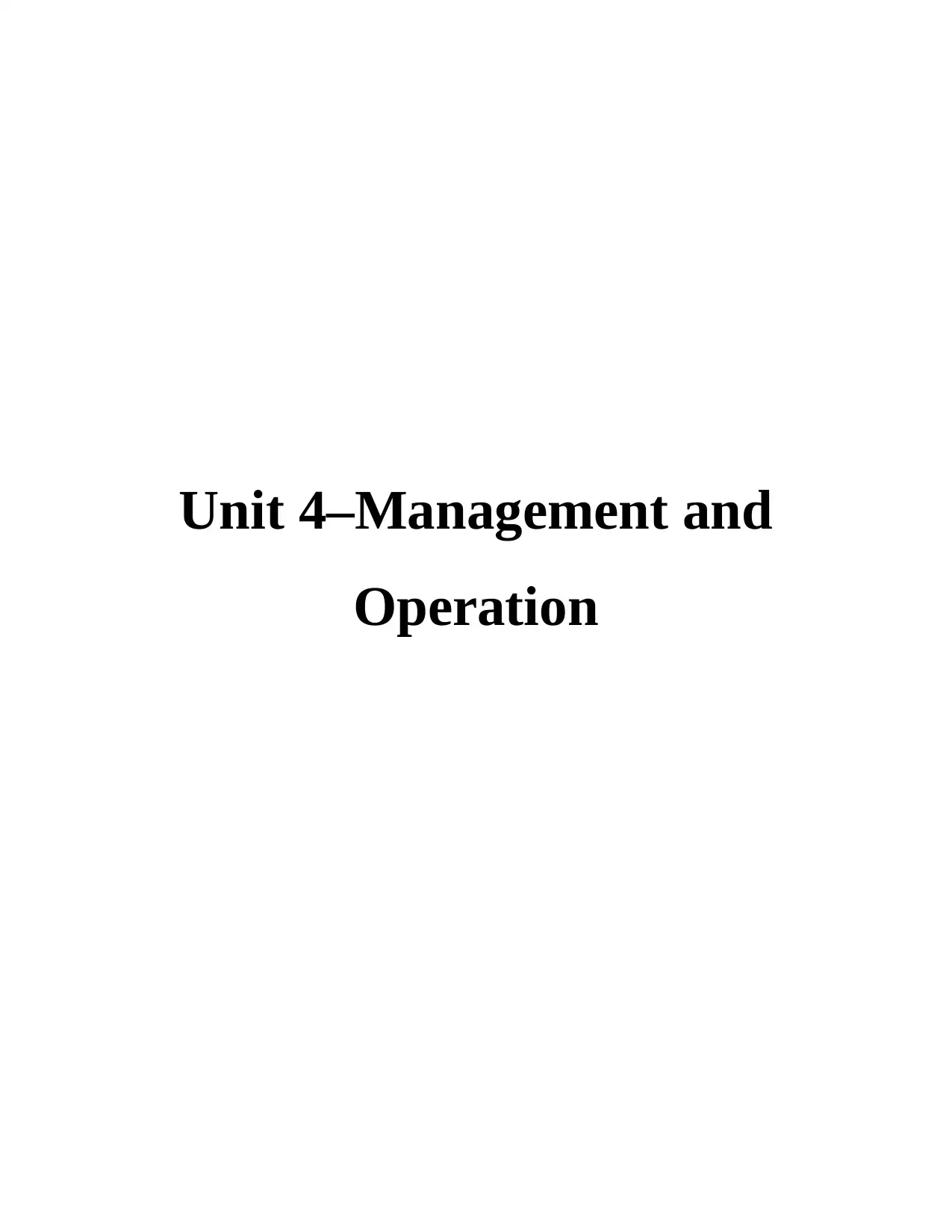
Unit 4–Management and
Operation
Operation
Paraphrase This Document
Need a fresh take? Get an instant paraphrase of this document with our AI Paraphraser
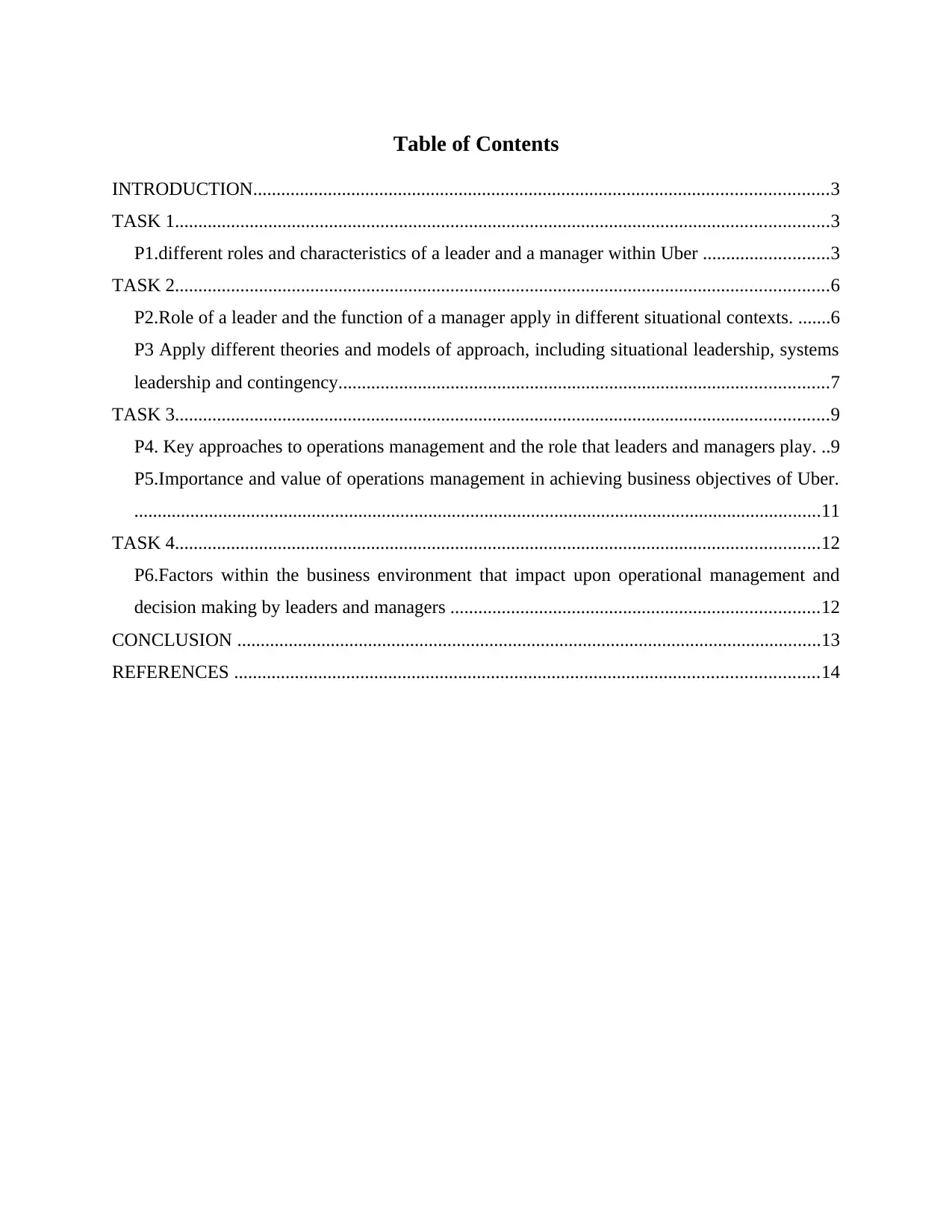
Table of Contents
INTRODUCTION...........................................................................................................................3
TASK 1............................................................................................................................................3
P1.different roles and characteristics of a leader and a manager within Uber ...........................3
TASK 2............................................................................................................................................6
P2.Role of a leader and the function of a manager apply in different situational contexts. .......6
P3 Apply different theories and models of approach, including situational leadership, systems
leadership and contingency.........................................................................................................7
TASK 3............................................................................................................................................9
P4. Key approaches to operations management and the role that leaders and managers play. ..9
P5.Importance and value of operations management in achieving business objectives of Uber.
...................................................................................................................................................11
TASK 4..........................................................................................................................................12
P6.Factors within the business environment that impact upon operational management and
decision making by leaders and managers ...............................................................................12
CONCLUSION .............................................................................................................................13
REFERENCES .............................................................................................................................14
INTRODUCTION...........................................................................................................................3
TASK 1............................................................................................................................................3
P1.different roles and characteristics of a leader and a manager within Uber ...........................3
TASK 2............................................................................................................................................6
P2.Role of a leader and the function of a manager apply in different situational contexts. .......6
P3 Apply different theories and models of approach, including situational leadership, systems
leadership and contingency.........................................................................................................7
TASK 3............................................................................................................................................9
P4. Key approaches to operations management and the role that leaders and managers play. ..9
P5.Importance and value of operations management in achieving business objectives of Uber.
...................................................................................................................................................11
TASK 4..........................................................................................................................................12
P6.Factors within the business environment that impact upon operational management and
decision making by leaders and managers ...............................................................................12
CONCLUSION .............................................................................................................................13
REFERENCES .............................................................................................................................14
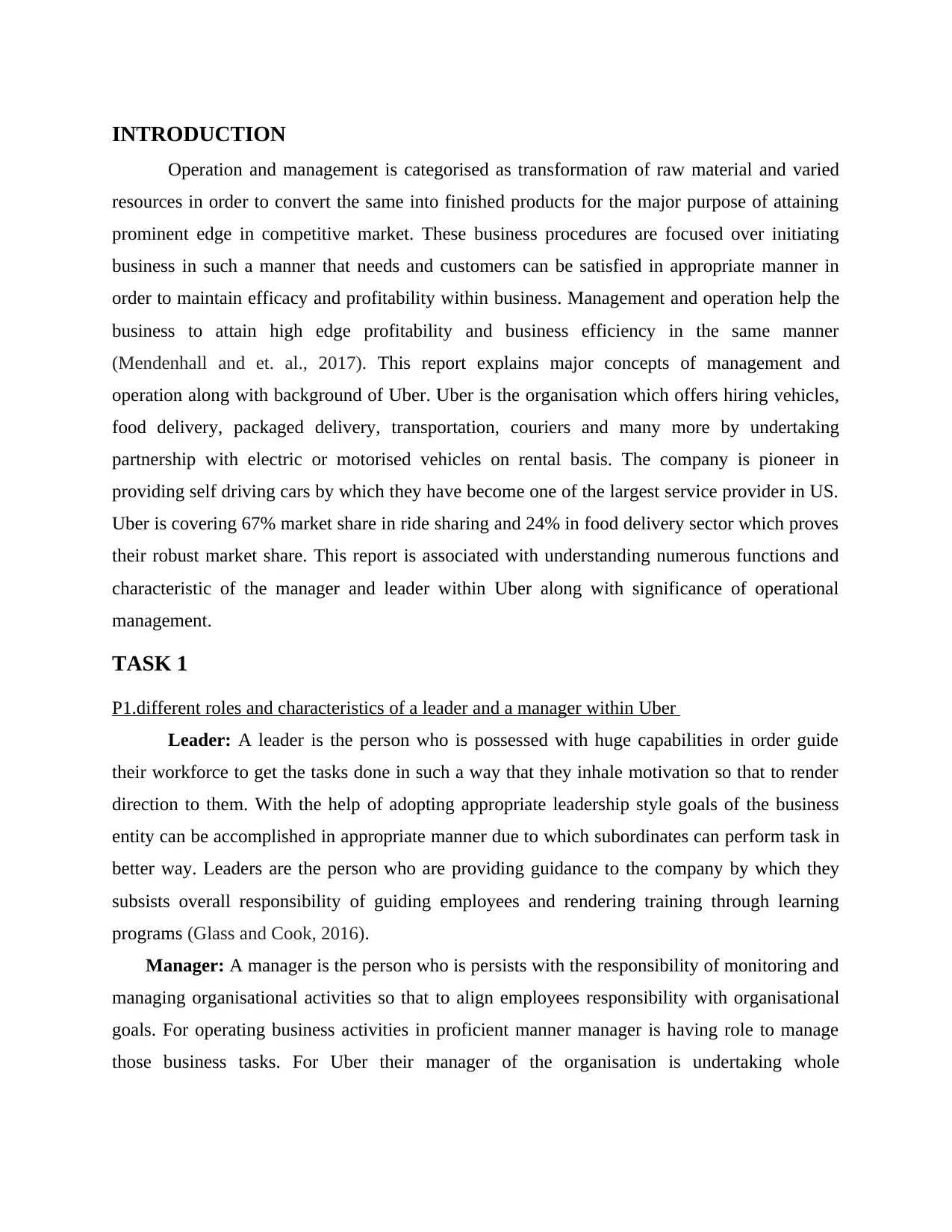
INTRODUCTION
Operation and management is categorised as transformation of raw material and varied
resources in order to convert the same into finished products for the major purpose of attaining
prominent edge in competitive market. These business procedures are focused over initiating
business in such a manner that needs and customers can be satisfied in appropriate manner in
order to maintain efficacy and profitability within business. Management and operation help the
business to attain high edge profitability and business efficiency in the same manner
(Mendenhall and et. al., 2017). This report explains major concepts of management and
operation along with background of Uber. Uber is the organisation which offers hiring vehicles,
food delivery, packaged delivery, transportation, couriers and many more by undertaking
partnership with electric or motorised vehicles on rental basis. The company is pioneer in
providing self driving cars by which they have become one of the largest service provider in US.
Uber is covering 67% market share in ride sharing and 24% in food delivery sector which proves
their robust market share. This report is associated with understanding numerous functions and
characteristic of the manager and leader within Uber along with significance of operational
management.
TASK 1
P1.different roles and characteristics of a leader and a manager within Uber
Leader: A leader is the person who is possessed with huge capabilities in order guide
their workforce to get the tasks done in such a way that they inhale motivation so that to render
direction to them. With the help of adopting appropriate leadership style goals of the business
entity can be accomplished in appropriate manner due to which subordinates can perform task in
better way. Leaders are the person who are providing guidance to the company by which they
subsists overall responsibility of guiding employees and rendering training through learning
programs (Glass and Cook, 2016).
Manager: A manager is the person who is persists with the responsibility of monitoring and
managing organisational activities so that to align employees responsibility with organisational
goals. For operating business activities in proficient manner manager is having role to manage
those business tasks. For Uber their manager of the organisation is undertaking whole
Operation and management is categorised as transformation of raw material and varied
resources in order to convert the same into finished products for the major purpose of attaining
prominent edge in competitive market. These business procedures are focused over initiating
business in such a manner that needs and customers can be satisfied in appropriate manner in
order to maintain efficacy and profitability within business. Management and operation help the
business to attain high edge profitability and business efficiency in the same manner
(Mendenhall and et. al., 2017). This report explains major concepts of management and
operation along with background of Uber. Uber is the organisation which offers hiring vehicles,
food delivery, packaged delivery, transportation, couriers and many more by undertaking
partnership with electric or motorised vehicles on rental basis. The company is pioneer in
providing self driving cars by which they have become one of the largest service provider in US.
Uber is covering 67% market share in ride sharing and 24% in food delivery sector which proves
their robust market share. This report is associated with understanding numerous functions and
characteristic of the manager and leader within Uber along with significance of operational
management.
TASK 1
P1.different roles and characteristics of a leader and a manager within Uber
Leader: A leader is the person who is possessed with huge capabilities in order guide
their workforce to get the tasks done in such a way that they inhale motivation so that to render
direction to them. With the help of adopting appropriate leadership style goals of the business
entity can be accomplished in appropriate manner due to which subordinates can perform task in
better way. Leaders are the person who are providing guidance to the company by which they
subsists overall responsibility of guiding employees and rendering training through learning
programs (Glass and Cook, 2016).
Manager: A manager is the person who is persists with the responsibility of monitoring and
managing organisational activities so that to align employees responsibility with organisational
goals. For operating business activities in proficient manner manager is having role to manage
those business tasks. For Uber their manager of the organisation is undertaking whole
⊘ This is a preview!⊘
Do you want full access?
Subscribe today to unlock all pages.

Trusted by 1+ million students worldwide
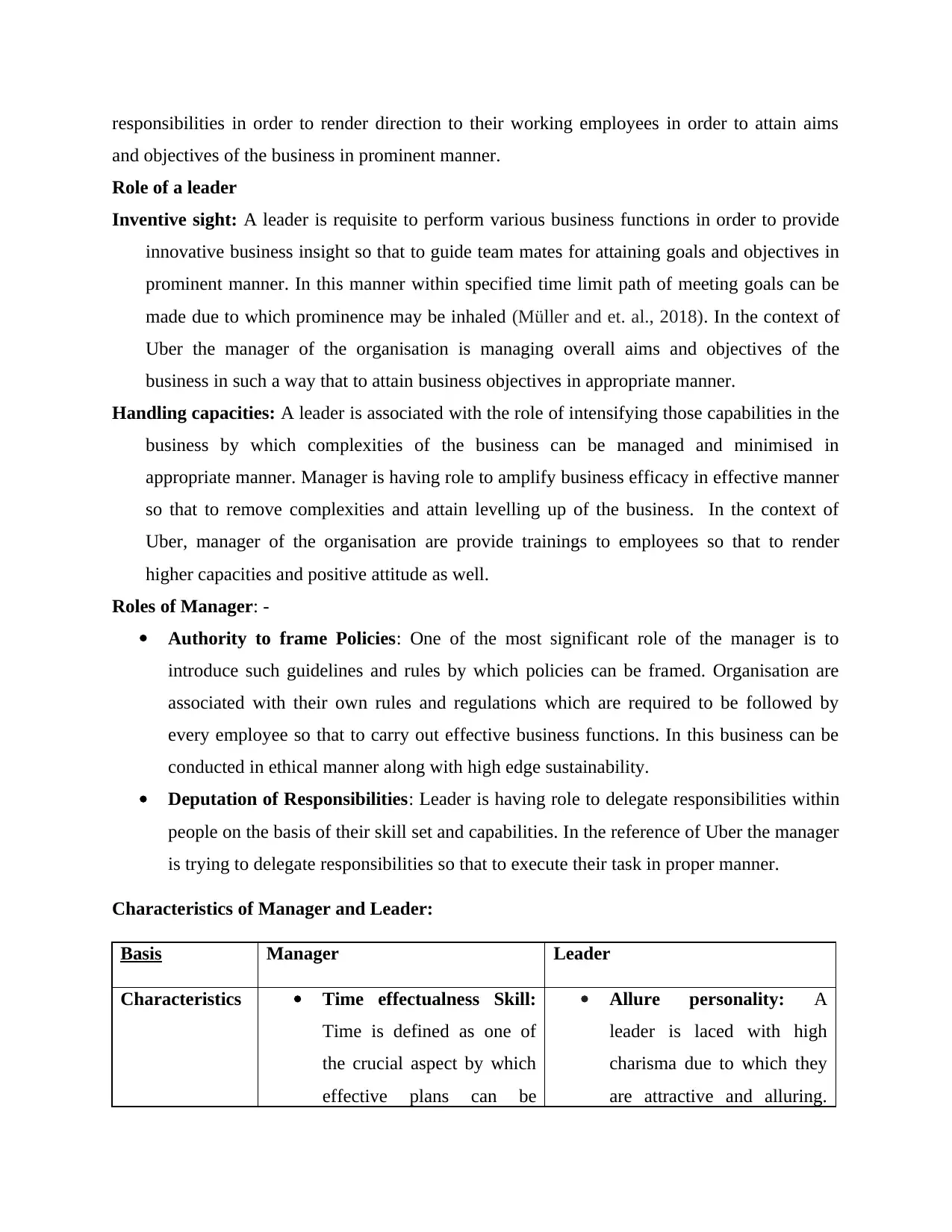
responsibilities in order to render direction to their working employees in order to attain aims
and objectives of the business in prominent manner.
Role of a leader
Inventive sight: A leader is requisite to perform various business functions in order to provide
innovative business insight so that to guide team mates for attaining goals and objectives in
prominent manner. In this manner within specified time limit path of meeting goals can be
made due to which prominence may be inhaled (Müller and et. al., 2018). In the context of
Uber the manager of the organisation is managing overall aims and objectives of the
business in such a way that to attain business objectives in appropriate manner.
Handling capacities: A leader is associated with the role of intensifying those capabilities in the
business by which complexities of the business can be managed and minimised in
appropriate manner. Manager is having role to amplify business efficacy in effective manner
so that to remove complexities and attain levelling up of the business. In the context of
Uber, manager of the organisation are provide trainings to employees so that to render
higher capacities and positive attitude as well.
Roles of Manager: -
Authority to frame Policies: One of the most significant role of the manager is to
introduce such guidelines and rules by which policies can be framed. Organisation are
associated with their own rules and regulations which are required to be followed by
every employee so that to carry out effective business functions. In this business can be
conducted in ethical manner along with high edge sustainability.
Deputation of Responsibilities: Leader is having role to delegate responsibilities within
people on the basis of their skill set and capabilities. In the reference of Uber the manager
is trying to delegate responsibilities so that to execute their task in proper manner.
Characteristics of Manager and Leader:
Basis Manager Leader
Characteristics Time effectualness Skill:
Time is defined as one of
the crucial aspect by which
effective plans can be
Allure personality: A
leader is laced with high
charisma due to which they
are attractive and alluring.
and objectives of the business in prominent manner.
Role of a leader
Inventive sight: A leader is requisite to perform various business functions in order to provide
innovative business insight so that to guide team mates for attaining goals and objectives in
prominent manner. In this manner within specified time limit path of meeting goals can be
made due to which prominence may be inhaled (Müller and et. al., 2018). In the context of
Uber the manager of the organisation is managing overall aims and objectives of the
business in such a way that to attain business objectives in appropriate manner.
Handling capacities: A leader is associated with the role of intensifying those capabilities in the
business by which complexities of the business can be managed and minimised in
appropriate manner. Manager is having role to amplify business efficacy in effective manner
so that to remove complexities and attain levelling up of the business. In the context of
Uber, manager of the organisation are provide trainings to employees so that to render
higher capacities and positive attitude as well.
Roles of Manager: -
Authority to frame Policies: One of the most significant role of the manager is to
introduce such guidelines and rules by which policies can be framed. Organisation are
associated with their own rules and regulations which are required to be followed by
every employee so that to carry out effective business functions. In this business can be
conducted in ethical manner along with high edge sustainability.
Deputation of Responsibilities: Leader is having role to delegate responsibilities within
people on the basis of their skill set and capabilities. In the reference of Uber the manager
is trying to delegate responsibilities so that to execute their task in proper manner.
Characteristics of Manager and Leader:
Basis Manager Leader
Characteristics Time effectualness Skill:
Time is defined as one of
the crucial aspect by which
effective plans can be
Allure personality: A
leader is laced with high
charisma due to which they
are attractive and alluring.
Paraphrase This Document
Need a fresh take? Get an instant paraphrase of this document with our AI Paraphraser
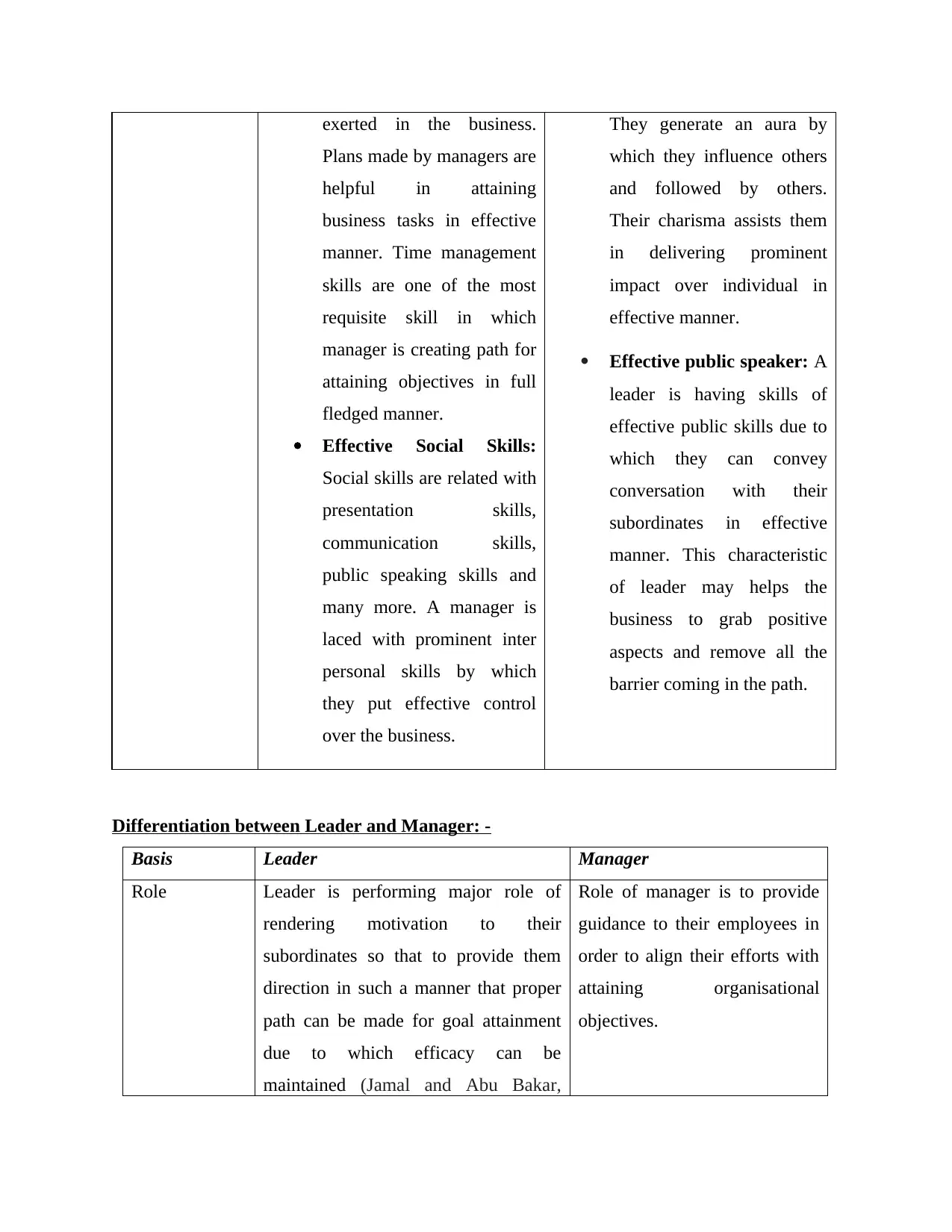
exerted in the business.
Plans made by managers are
helpful in attaining
business tasks in effective
manner. Time management
skills are one of the most
requisite skill in which
manager is creating path for
attaining objectives in full
fledged manner.
Effective Social Skills:
Social skills are related with
presentation skills,
communication skills,
public speaking skills and
many more. A manager is
laced with prominent inter
personal skills by which
they put effective control
over the business.
They generate an aura by
which they influence others
and followed by others.
Their charisma assists them
in delivering prominent
impact over individual in
effective manner.
Effective public speaker: A
leader is having skills of
effective public skills due to
which they can convey
conversation with their
subordinates in effective
manner. This characteristic
of leader may helps the
business to grab positive
aspects and remove all the
barrier coming in the path.
Differentiation between Leader and Manager: -
Basis Leader Manager
Role Leader is performing major role of
rendering motivation to their
subordinates so that to provide them
direction in such a manner that proper
path can be made for goal attainment
due to which efficacy can be
maintained (Jamal and Abu Bakar,
Role of manager is to provide
guidance to their employees in
order to align their efforts with
attaining organisational
objectives.
Plans made by managers are
helpful in attaining
business tasks in effective
manner. Time management
skills are one of the most
requisite skill in which
manager is creating path for
attaining objectives in full
fledged manner.
Effective Social Skills:
Social skills are related with
presentation skills,
communication skills,
public speaking skills and
many more. A manager is
laced with prominent inter
personal skills by which
they put effective control
over the business.
They generate an aura by
which they influence others
and followed by others.
Their charisma assists them
in delivering prominent
impact over individual in
effective manner.
Effective public speaker: A
leader is having skills of
effective public skills due to
which they can convey
conversation with their
subordinates in effective
manner. This characteristic
of leader may helps the
business to grab positive
aspects and remove all the
barrier coming in the path.
Differentiation between Leader and Manager: -
Basis Leader Manager
Role Leader is performing major role of
rendering motivation to their
subordinates so that to provide them
direction in such a manner that proper
path can be made for goal attainment
due to which efficacy can be
maintained (Jamal and Abu Bakar,
Role of manager is to provide
guidance to their employees in
order to align their efforts with
attaining organisational
objectives.
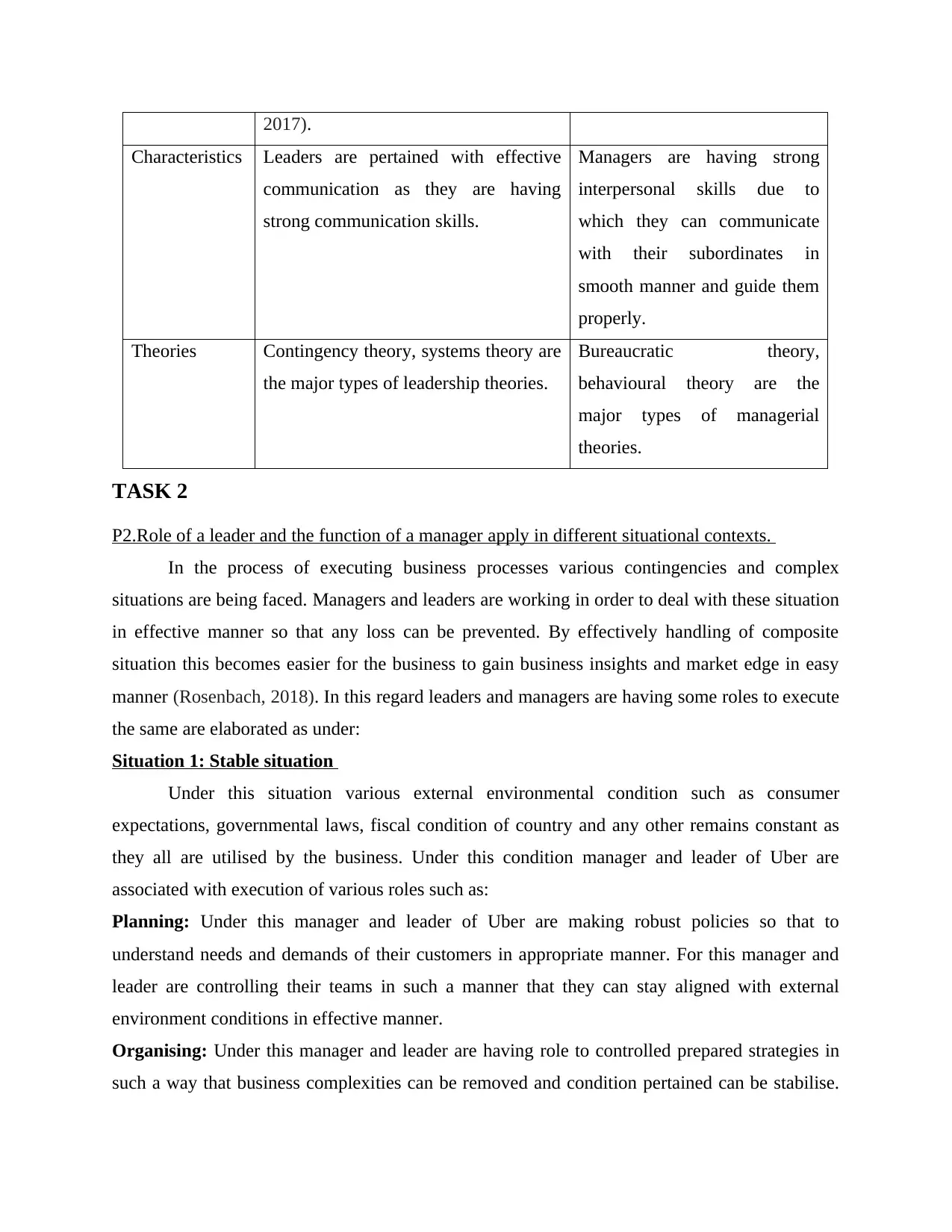
2017).
Characteristics Leaders are pertained with effective
communication as they are having
strong communication skills.
Managers are having strong
interpersonal skills due to
which they can communicate
with their subordinates in
smooth manner and guide them
properly.
Theories Contingency theory, systems theory are
the major types of leadership theories.
Bureaucratic theory,
behavioural theory are the
major types of managerial
theories.
TASK 2
P2.Role of a leader and the function of a manager apply in different situational contexts.
In the process of executing business processes various contingencies and complex
situations are being faced. Managers and leaders are working in order to deal with these situation
in effective manner so that any loss can be prevented. By effectively handling of composite
situation this becomes easier for the business to gain business insights and market edge in easy
manner (Rosenbach, 2018). In this regard leaders and managers are having some roles to execute
the same are elaborated as under:
Situation 1: Stable situation
Under this situation various external environmental condition such as consumer
expectations, governmental laws, fiscal condition of country and any other remains constant as
they all are utilised by the business. Under this condition manager and leader of Uber are
associated with execution of various roles such as:
Planning: Under this manager and leader of Uber are making robust policies so that to
understand needs and demands of their customers in appropriate manner. For this manager and
leader are controlling their teams in such a manner that they can stay aligned with external
environment conditions in effective manner.
Organising: Under this manager and leader are having role to controlled prepared strategies in
such a way that business complexities can be removed and condition pertained can be stabilise.
Characteristics Leaders are pertained with effective
communication as they are having
strong communication skills.
Managers are having strong
interpersonal skills due to
which they can communicate
with their subordinates in
smooth manner and guide them
properly.
Theories Contingency theory, systems theory are
the major types of leadership theories.
Bureaucratic theory,
behavioural theory are the
major types of managerial
theories.
TASK 2
P2.Role of a leader and the function of a manager apply in different situational contexts.
In the process of executing business processes various contingencies and complex
situations are being faced. Managers and leaders are working in order to deal with these situation
in effective manner so that any loss can be prevented. By effectively handling of composite
situation this becomes easier for the business to gain business insights and market edge in easy
manner (Rosenbach, 2018). In this regard leaders and managers are having some roles to execute
the same are elaborated as under:
Situation 1: Stable situation
Under this situation various external environmental condition such as consumer
expectations, governmental laws, fiscal condition of country and any other remains constant as
they all are utilised by the business. Under this condition manager and leader of Uber are
associated with execution of various roles such as:
Planning: Under this manager and leader of Uber are making robust policies so that to
understand needs and demands of their customers in appropriate manner. For this manager and
leader are controlling their teams in such a manner that they can stay aligned with external
environment conditions in effective manner.
Organising: Under this manager and leader are having role to controlled prepared strategies in
such a way that business complexities can be removed and condition pertained can be stabilise.
⊘ This is a preview!⊘
Do you want full access?
Subscribe today to unlock all pages.

Trusted by 1+ million students worldwide
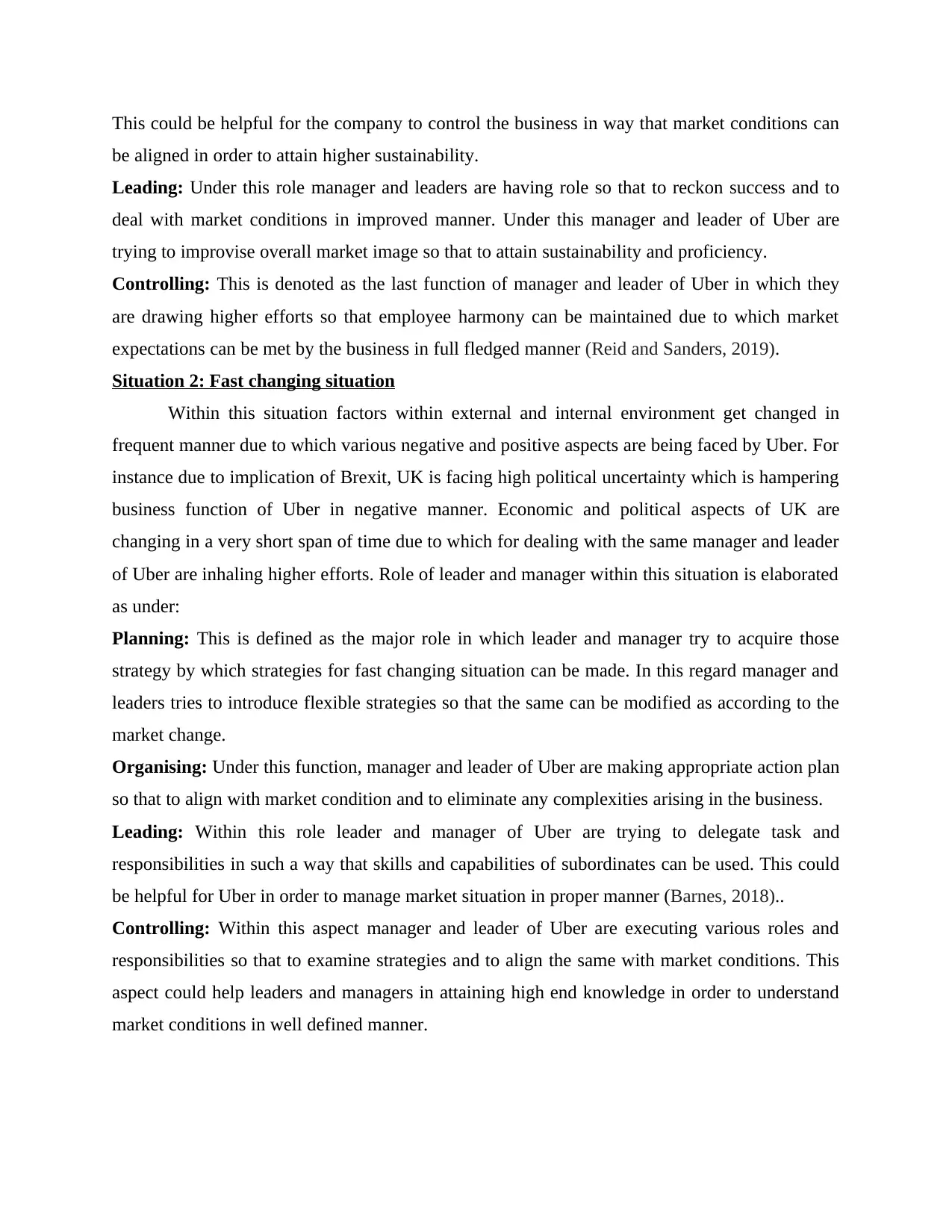
This could be helpful for the company to control the business in way that market conditions can
be aligned in order to attain higher sustainability.
Leading: Under this role manager and leaders are having role so that to reckon success and to
deal with market conditions in improved manner. Under this manager and leader of Uber are
trying to improvise overall market image so that to attain sustainability and proficiency.
Controlling: This is denoted as the last function of manager and leader of Uber in which they
are drawing higher efforts so that employee harmony can be maintained due to which market
expectations can be met by the business in full fledged manner (Reid and Sanders, 2019).
Situation 2: Fast changing situation
Within this situation factors within external and internal environment get changed in
frequent manner due to which various negative and positive aspects are being faced by Uber. For
instance due to implication of Brexit, UK is facing high political uncertainty which is hampering
business function of Uber in negative manner. Economic and political aspects of UK are
changing in a very short span of time due to which for dealing with the same manager and leader
of Uber are inhaling higher efforts. Role of leader and manager within this situation is elaborated
as under:
Planning: This is defined as the major role in which leader and manager try to acquire those
strategy by which strategies for fast changing situation can be made. In this regard manager and
leaders tries to introduce flexible strategies so that the same can be modified as according to the
market change.
Organising: Under this function, manager and leader of Uber are making appropriate action plan
so that to align with market condition and to eliminate any complexities arising in the business.
Leading: Within this role leader and manager of Uber are trying to delegate task and
responsibilities in such a way that skills and capabilities of subordinates can be used. This could
be helpful for Uber in order to manage market situation in proper manner (Barnes, 2018)..
Controlling: Within this aspect manager and leader of Uber are executing various roles and
responsibilities so that to examine strategies and to align the same with market conditions. This
aspect could help leaders and managers in attaining high end knowledge in order to understand
market conditions in well defined manner.
be aligned in order to attain higher sustainability.
Leading: Under this role manager and leaders are having role so that to reckon success and to
deal with market conditions in improved manner. Under this manager and leader of Uber are
trying to improvise overall market image so that to attain sustainability and proficiency.
Controlling: This is denoted as the last function of manager and leader of Uber in which they
are drawing higher efforts so that employee harmony can be maintained due to which market
expectations can be met by the business in full fledged manner (Reid and Sanders, 2019).
Situation 2: Fast changing situation
Within this situation factors within external and internal environment get changed in
frequent manner due to which various negative and positive aspects are being faced by Uber. For
instance due to implication of Brexit, UK is facing high political uncertainty which is hampering
business function of Uber in negative manner. Economic and political aspects of UK are
changing in a very short span of time due to which for dealing with the same manager and leader
of Uber are inhaling higher efforts. Role of leader and manager within this situation is elaborated
as under:
Planning: This is defined as the major role in which leader and manager try to acquire those
strategy by which strategies for fast changing situation can be made. In this regard manager and
leaders tries to introduce flexible strategies so that the same can be modified as according to the
market change.
Organising: Under this function, manager and leader of Uber are making appropriate action plan
so that to align with market condition and to eliminate any complexities arising in the business.
Leading: Within this role leader and manager of Uber are trying to delegate task and
responsibilities in such a way that skills and capabilities of subordinates can be used. This could
be helpful for Uber in order to manage market situation in proper manner (Barnes, 2018)..
Controlling: Within this aspect manager and leader of Uber are executing various roles and
responsibilities so that to examine strategies and to align the same with market conditions. This
aspect could help leaders and managers in attaining high end knowledge in order to understand
market conditions in well defined manner.
Paraphrase This Document
Need a fresh take? Get an instant paraphrase of this document with our AI Paraphraser
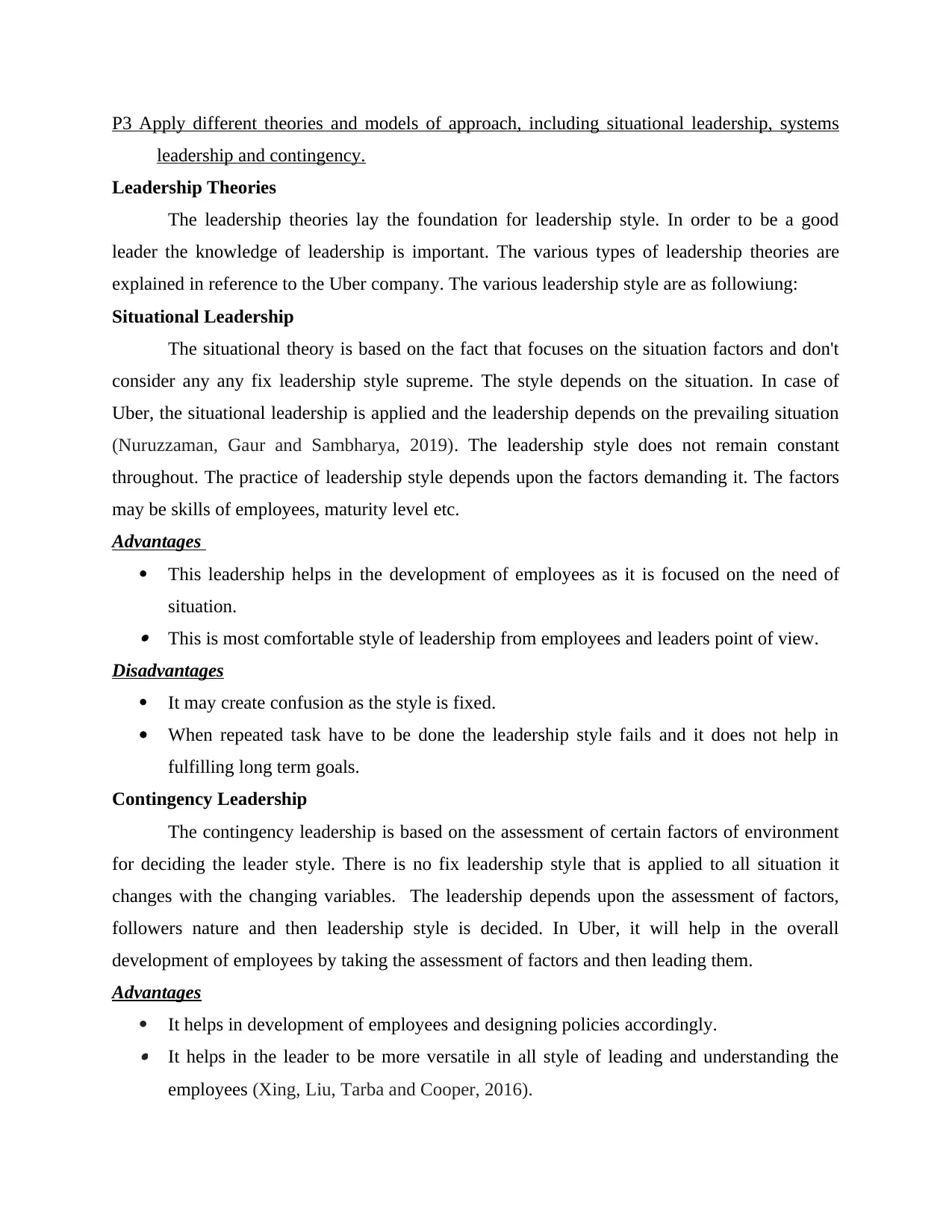
P3 Apply different theories and models of approach, including situational leadership, systems
leadership and contingency.
Leadership Theories
The leadership theories lay the foundation for leadership style. In order to be a good
leader the knowledge of leadership is important. The various types of leadership theories are
explained in reference to the Uber company. The various leadership style are as followiung:
Situational Leadership
The situational theory is based on the fact that focuses on the situation factors and don't
consider any any fix leadership style supreme. The style depends on the situation. In case of
Uber, the situational leadership is applied and the leadership depends on the prevailing situation
(Nuruzzaman, Gaur and Sambharya, 2019). The leadership style does not remain constant
throughout. The practice of leadership style depends upon the factors demanding it. The factors
may be skills of employees, maturity level etc.
Advantages
This leadership helps in the development of employees as it is focused on the need of
situation. This is most comfortable style of leadership from employees and leaders point of view.
Disadvantages
It may create confusion as the style is fixed.
When repeated task have to be done the leadership style fails and it does not help in
fulfilling long term goals.
Contingency Leadership
The contingency leadership is based on the assessment of certain factors of environment
for deciding the leader style. There is no fix leadership style that is applied to all situation it
changes with the changing variables. The leadership depends upon the assessment of factors,
followers nature and then leadership style is decided. In Uber, it will help in the overall
development of employees by taking the assessment of factors and then leading them.
Advantages
It helps in development of employees and designing policies accordingly. It helps in the leader to be more versatile in all style of leading and understanding the
employees (Xing, Liu, Tarba and Cooper, 2016).
leadership and contingency.
Leadership Theories
The leadership theories lay the foundation for leadership style. In order to be a good
leader the knowledge of leadership is important. The various types of leadership theories are
explained in reference to the Uber company. The various leadership style are as followiung:
Situational Leadership
The situational theory is based on the fact that focuses on the situation factors and don't
consider any any fix leadership style supreme. The style depends on the situation. In case of
Uber, the situational leadership is applied and the leadership depends on the prevailing situation
(Nuruzzaman, Gaur and Sambharya, 2019). The leadership style does not remain constant
throughout. The practice of leadership style depends upon the factors demanding it. The factors
may be skills of employees, maturity level etc.
Advantages
This leadership helps in the development of employees as it is focused on the need of
situation. This is most comfortable style of leadership from employees and leaders point of view.
Disadvantages
It may create confusion as the style is fixed.
When repeated task have to be done the leadership style fails and it does not help in
fulfilling long term goals.
Contingency Leadership
The contingency leadership is based on the assessment of certain factors of environment
for deciding the leader style. There is no fix leadership style that is applied to all situation it
changes with the changing variables. The leadership depends upon the assessment of factors,
followers nature and then leadership style is decided. In Uber, it will help in the overall
development of employees by taking the assessment of factors and then leading them.
Advantages
It helps in development of employees and designing policies accordingly. It helps in the leader to be more versatile in all style of leading and understanding the
employees (Xing, Liu, Tarba and Cooper, 2016).
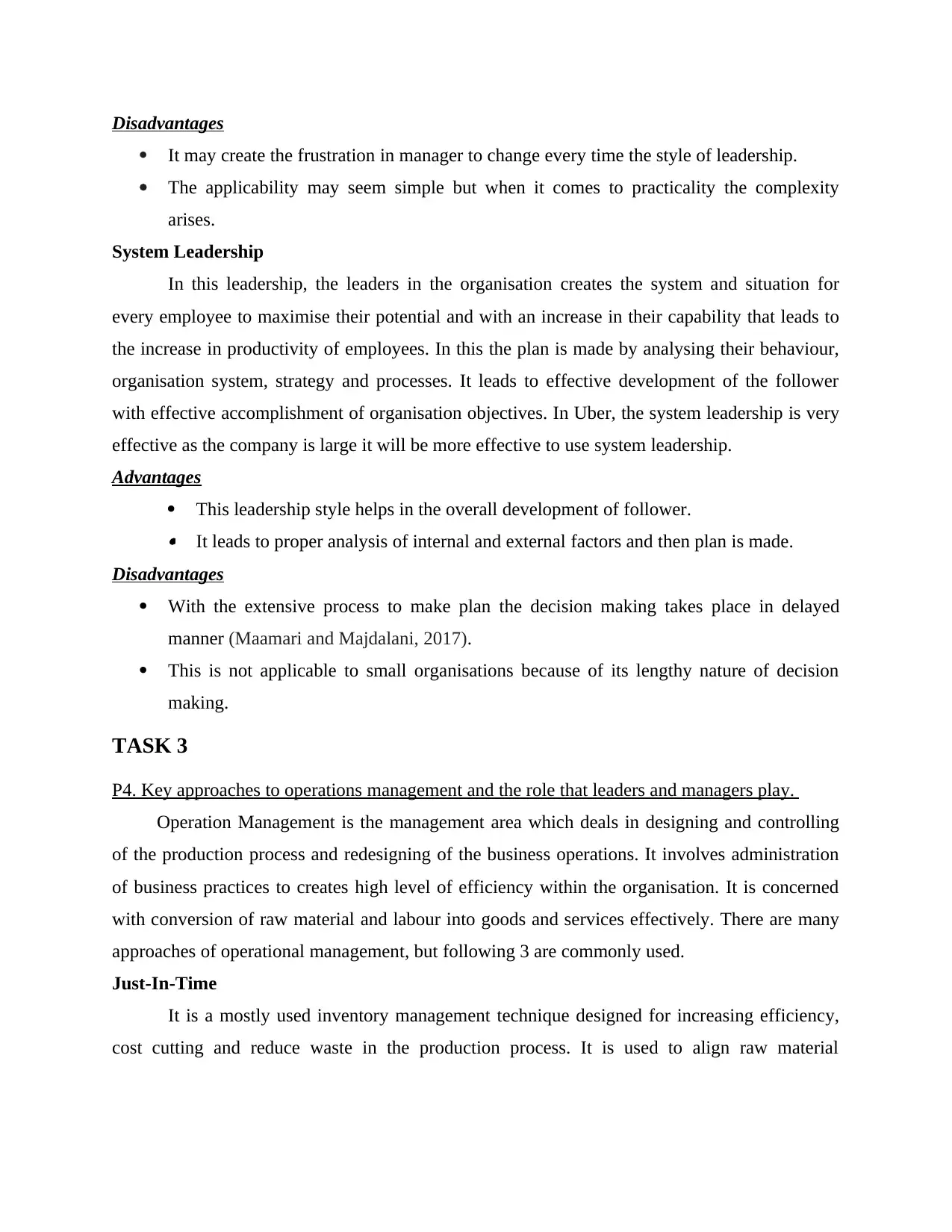
Disadvantages
It may create the frustration in manager to change every time the style of leadership.
The applicability may seem simple but when it comes to practicality the complexity
arises.
System Leadership
In this leadership, the leaders in the organisation creates the system and situation for
every employee to maximise their potential and with an increase in their capability that leads to
the increase in productivity of employees. In this the plan is made by analysing their behaviour,
organisation system, strategy and processes. It leads to effective development of the follower
with effective accomplishment of organisation objectives. In Uber, the system leadership is very
effective as the company is large it will be more effective to use system leadership.
Advantages
This leadership style helps in the overall development of follower.
It leads to proper analysis of internal and external factors and then plan is made.
Disadvantages
With the extensive process to make plan the decision making takes place in delayed
manner (Maamari and Majdalani, 2017).
This is not applicable to small organisations because of its lengthy nature of decision
making.
TASK 3
P4. Key approaches to operations management and the role that leaders and managers play.
Operation Management is the management area which deals in designing and controlling
of the production process and redesigning of the business operations. It involves administration
of business practices to creates high level of efficiency within the organisation. It is concerned
with conversion of raw material and labour into goods and services effectively. There are many
approaches of operational management, but following 3 are commonly used.
Just-In-Time
It is a mostly used inventory management technique designed for increasing efficiency,
cost cutting and reduce waste in the production process. It is used to align raw material
It may create the frustration in manager to change every time the style of leadership.
The applicability may seem simple but when it comes to practicality the complexity
arises.
System Leadership
In this leadership, the leaders in the organisation creates the system and situation for
every employee to maximise their potential and with an increase in their capability that leads to
the increase in productivity of employees. In this the plan is made by analysing their behaviour,
organisation system, strategy and processes. It leads to effective development of the follower
with effective accomplishment of organisation objectives. In Uber, the system leadership is very
effective as the company is large it will be more effective to use system leadership.
Advantages
This leadership style helps in the overall development of follower.
It leads to proper analysis of internal and external factors and then plan is made.
Disadvantages
With the extensive process to make plan the decision making takes place in delayed
manner (Maamari and Majdalani, 2017).
This is not applicable to small organisations because of its lengthy nature of decision
making.
TASK 3
P4. Key approaches to operations management and the role that leaders and managers play.
Operation Management is the management area which deals in designing and controlling
of the production process and redesigning of the business operations. It involves administration
of business practices to creates high level of efficiency within the organisation. It is concerned
with conversion of raw material and labour into goods and services effectively. There are many
approaches of operational management, but following 3 are commonly used.
Just-In-Time
It is a mostly used inventory management technique designed for increasing efficiency,
cost cutting and reduce waste in the production process. It is used to align raw material
⊘ This is a preview!⊘
Do you want full access?
Subscribe today to unlock all pages.

Trusted by 1+ million students worldwide
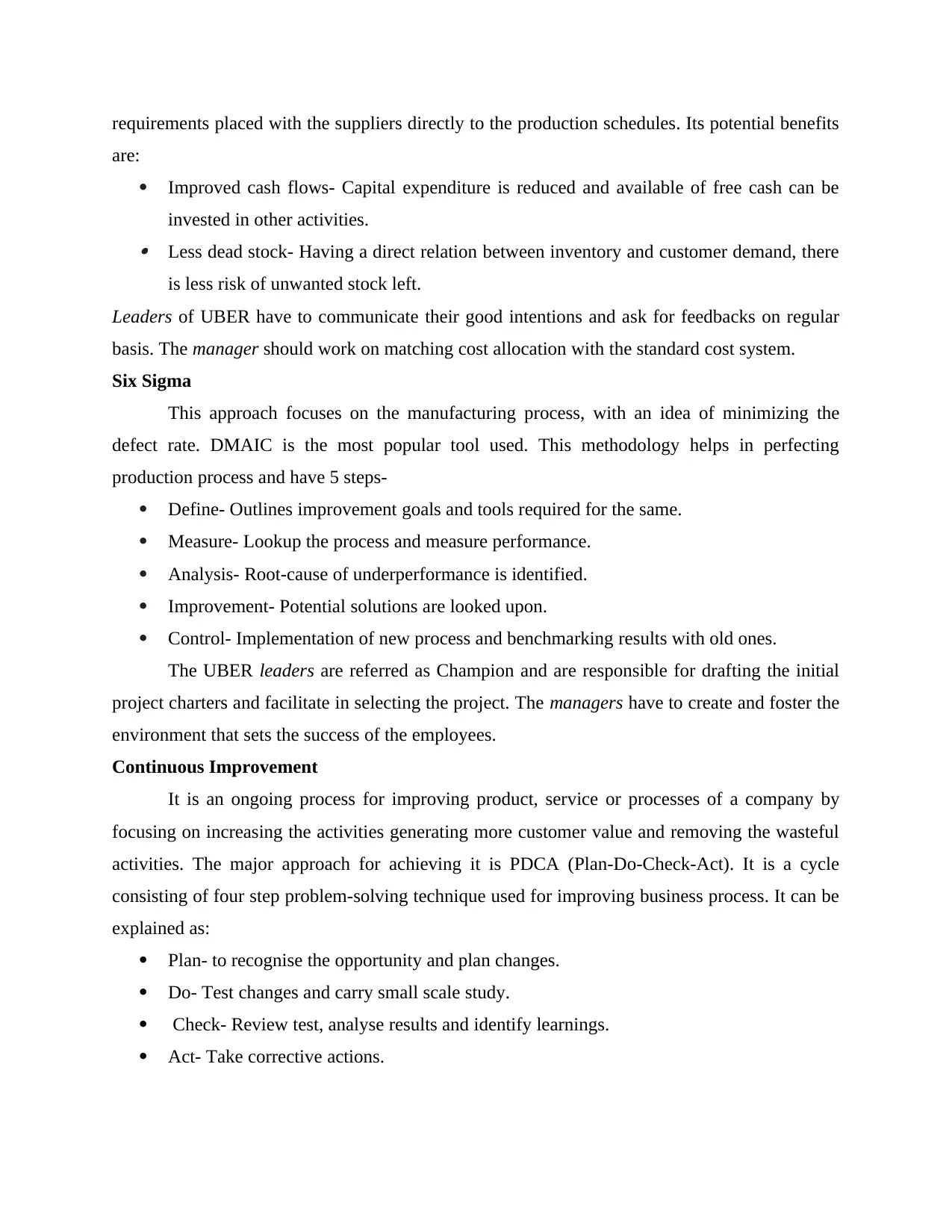
requirements placed with the suppliers directly to the production schedules. Its potential benefits
are:
Improved cash flows- Capital expenditure is reduced and available of free cash can be
invested in other activities. Less dead stock- Having a direct relation between inventory and customer demand, there
is less risk of unwanted stock left.
Leaders of UBER have to communicate their good intentions and ask for feedbacks on regular
basis. The manager should work on matching cost allocation with the standard cost system.
Six Sigma
This approach focuses on the manufacturing process, with an idea of minimizing the
defect rate. DMAIC is the most popular tool used. This methodology helps in perfecting
production process and have 5 steps-
Define- Outlines improvement goals and tools required for the same.
Measure- Lookup the process and measure performance.
Analysis- Root-cause of underperformance is identified.
Improvement- Potential solutions are looked upon.
Control- Implementation of new process and benchmarking results with old ones.
The UBER leaders are referred as Champion and are responsible for drafting the initial
project charters and facilitate in selecting the project. The managers have to create and foster the
environment that sets the success of the employees.
Continuous Improvement
It is an ongoing process for improving product, service or processes of a company by
focusing on increasing the activities generating more customer value and removing the wasteful
activities. The major approach for achieving it is PDCA (Plan-Do-Check-Act). It is a cycle
consisting of four step problem-solving technique used for improving business process. It can be
explained as:
Plan- to recognise the opportunity and plan changes.
Do- Test changes and carry small scale study.
Check- Review test, analyse results and identify learnings.
Act- Take corrective actions.
are:
Improved cash flows- Capital expenditure is reduced and available of free cash can be
invested in other activities. Less dead stock- Having a direct relation between inventory and customer demand, there
is less risk of unwanted stock left.
Leaders of UBER have to communicate their good intentions and ask for feedbacks on regular
basis. The manager should work on matching cost allocation with the standard cost system.
Six Sigma
This approach focuses on the manufacturing process, with an idea of minimizing the
defect rate. DMAIC is the most popular tool used. This methodology helps in perfecting
production process and have 5 steps-
Define- Outlines improvement goals and tools required for the same.
Measure- Lookup the process and measure performance.
Analysis- Root-cause of underperformance is identified.
Improvement- Potential solutions are looked upon.
Control- Implementation of new process and benchmarking results with old ones.
The UBER leaders are referred as Champion and are responsible for drafting the initial
project charters and facilitate in selecting the project. The managers have to create and foster the
environment that sets the success of the employees.
Continuous Improvement
It is an ongoing process for improving product, service or processes of a company by
focusing on increasing the activities generating more customer value and removing the wasteful
activities. The major approach for achieving it is PDCA (Plan-Do-Check-Act). It is a cycle
consisting of four step problem-solving technique used for improving business process. It can be
explained as:
Plan- to recognise the opportunity and plan changes.
Do- Test changes and carry small scale study.
Check- Review test, analyse results and identify learnings.
Act- Take corrective actions.
Paraphrase This Document
Need a fresh take? Get an instant paraphrase of this document with our AI Paraphraser
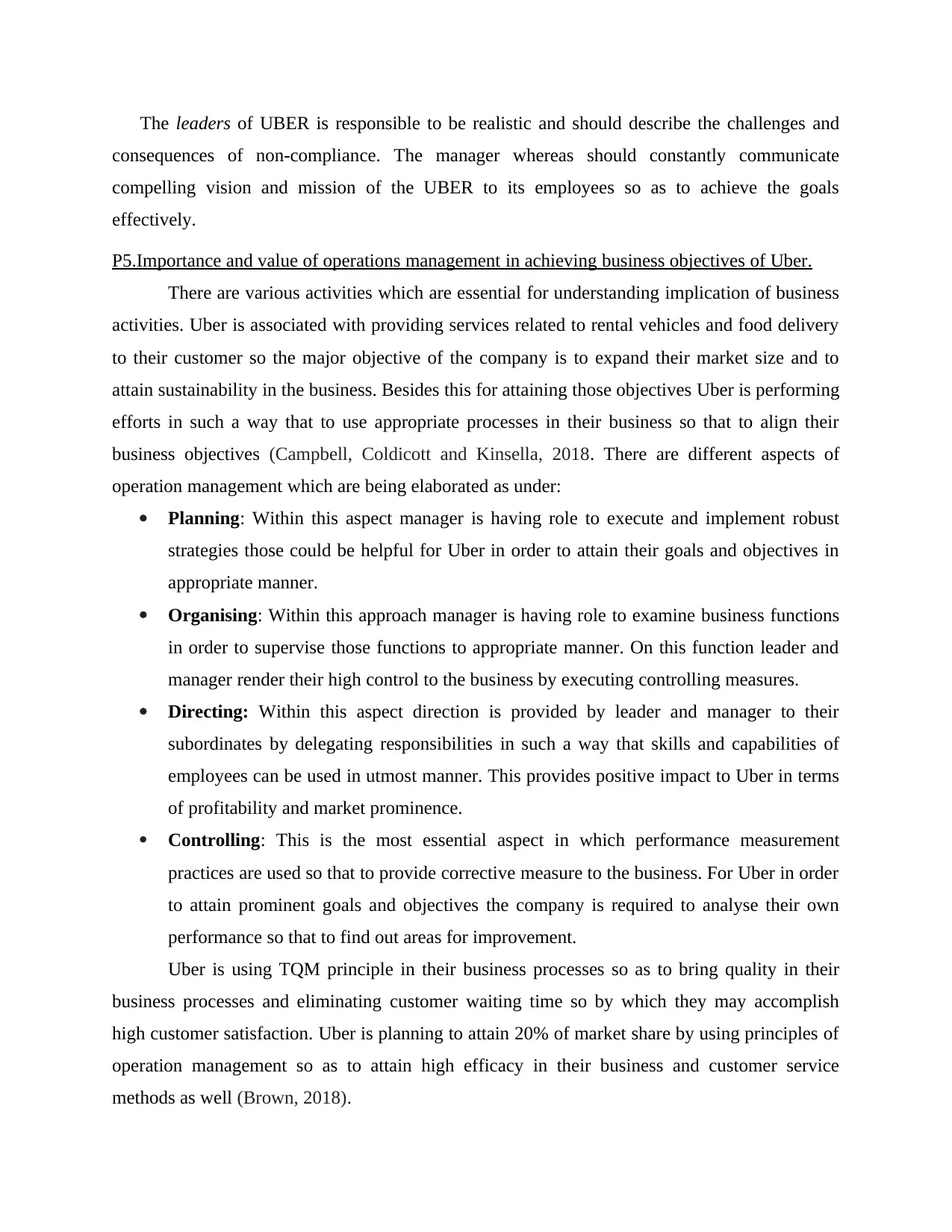
The leaders of UBER is responsible to be realistic and should describe the challenges and
consequences of non-compliance. The manager whereas should constantly communicate
compelling vision and mission of the UBER to its employees so as to achieve the goals
effectively.
P5.Importance and value of operations management in achieving business objectives of Uber.
There are various activities which are essential for understanding implication of business
activities. Uber is associated with providing services related to rental vehicles and food delivery
to their customer so the major objective of the company is to expand their market size and to
attain sustainability in the business. Besides this for attaining those objectives Uber is performing
efforts in such a way that to use appropriate processes in their business so that to align their
business objectives (Campbell, Coldicott and Kinsella, 2018. There are different aspects of
operation management which are being elaborated as under:
Planning: Within this aspect manager is having role to execute and implement robust
strategies those could be helpful for Uber in order to attain their goals and objectives in
appropriate manner.
Organising: Within this approach manager is having role to examine business functions
in order to supervise those functions to appropriate manner. On this function leader and
manager render their high control to the business by executing controlling measures.
Directing: Within this aspect direction is provided by leader and manager to their
subordinates by delegating responsibilities in such a way that skills and capabilities of
employees can be used in utmost manner. This provides positive impact to Uber in terms
of profitability and market prominence.
Controlling: This is the most essential aspect in which performance measurement
practices are used so that to provide corrective measure to the business. For Uber in order
to attain prominent goals and objectives the company is required to analyse their own
performance so that to find out areas for improvement.
Uber is using TQM principle in their business processes so as to bring quality in their
business processes and eliminating customer waiting time so by which they may accomplish
high customer satisfaction. Uber is planning to attain 20% of market share by using principles of
operation management so as to attain high efficacy in their business and customer service
methods as well (Brown, 2018).
consequences of non-compliance. The manager whereas should constantly communicate
compelling vision and mission of the UBER to its employees so as to achieve the goals
effectively.
P5.Importance and value of operations management in achieving business objectives of Uber.
There are various activities which are essential for understanding implication of business
activities. Uber is associated with providing services related to rental vehicles and food delivery
to their customer so the major objective of the company is to expand their market size and to
attain sustainability in the business. Besides this for attaining those objectives Uber is performing
efforts in such a way that to use appropriate processes in their business so that to align their
business objectives (Campbell, Coldicott and Kinsella, 2018. There are different aspects of
operation management which are being elaborated as under:
Planning: Within this aspect manager is having role to execute and implement robust
strategies those could be helpful for Uber in order to attain their goals and objectives in
appropriate manner.
Organising: Within this approach manager is having role to examine business functions
in order to supervise those functions to appropriate manner. On this function leader and
manager render their high control to the business by executing controlling measures.
Directing: Within this aspect direction is provided by leader and manager to their
subordinates by delegating responsibilities in such a way that skills and capabilities of
employees can be used in utmost manner. This provides positive impact to Uber in terms
of profitability and market prominence.
Controlling: This is the most essential aspect in which performance measurement
practices are used so that to provide corrective measure to the business. For Uber in order
to attain prominent goals and objectives the company is required to analyse their own
performance so that to find out areas for improvement.
Uber is using TQM principle in their business processes so as to bring quality in their
business processes and eliminating customer waiting time so by which they may accomplish
high customer satisfaction. Uber is planning to attain 20% of market share by using principles of
operation management so as to attain high efficacy in their business and customer service
methods as well (Brown, 2018).
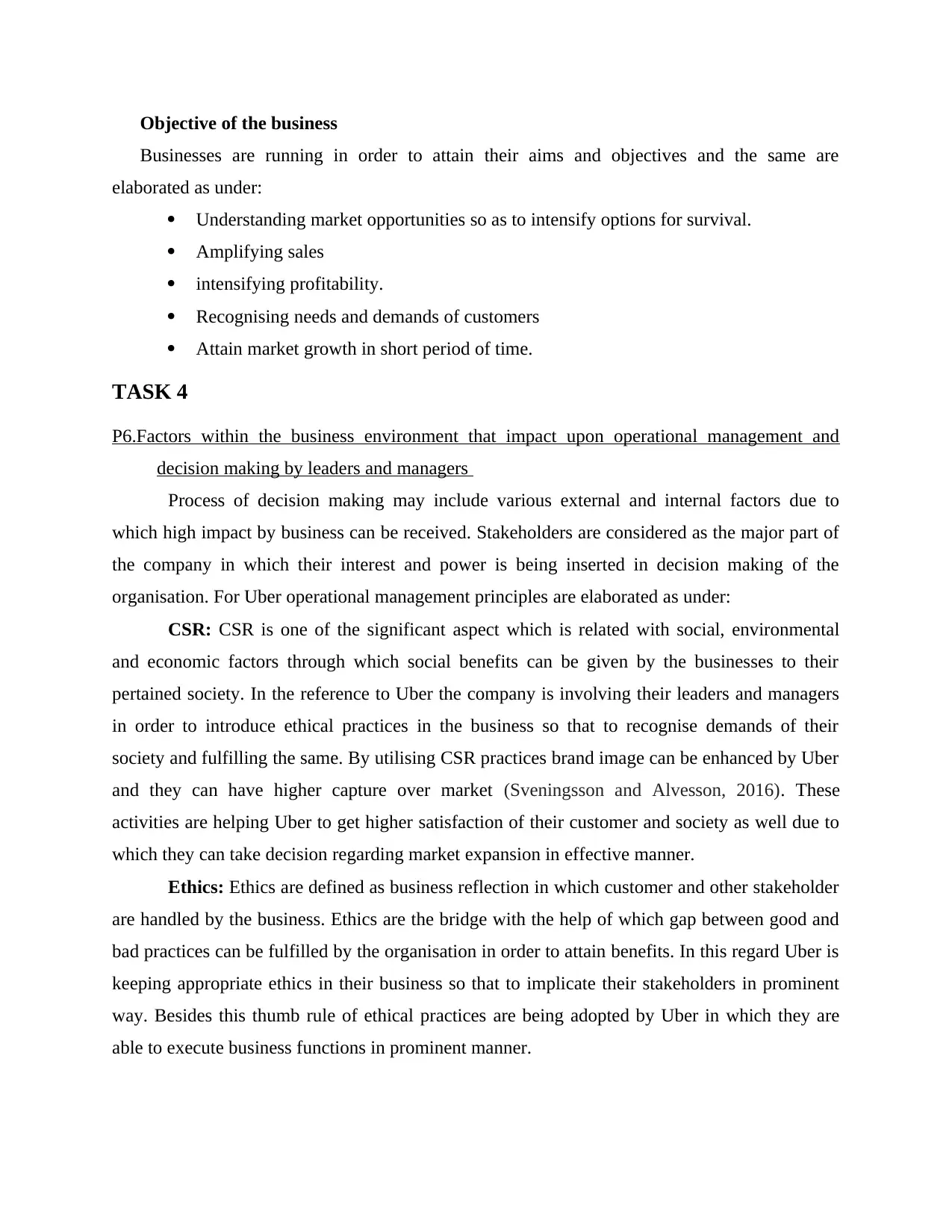
Objective of the business
Businesses are running in order to attain their aims and objectives and the same are
elaborated as under:
Understanding market opportunities so as to intensify options for survival.
Amplifying sales
intensifying profitability.
Recognising needs and demands of customers
Attain market growth in short period of time.
TASK 4
P6.Factors within the business environment that impact upon operational management and
decision making by leaders and managers
Process of decision making may include various external and internal factors due to
which high impact by business can be received. Stakeholders are considered as the major part of
the company in which their interest and power is being inserted in decision making of the
organisation. For Uber operational management principles are elaborated as under:
CSR: CSR is one of the significant aspect which is related with social, environmental
and economic factors through which social benefits can be given by the businesses to their
pertained society. In the reference to Uber the company is involving their leaders and managers
in order to introduce ethical practices in the business so that to recognise demands of their
society and fulfilling the same. By utilising CSR practices brand image can be enhanced by Uber
and they can have higher capture over market (Sveningsson and Alvesson, 2016). These
activities are helping Uber to get higher satisfaction of their customer and society as well due to
which they can take decision regarding market expansion in effective manner.
Ethics: Ethics are defined as business reflection in which customer and other stakeholder
are handled by the business. Ethics are the bridge with the help of which gap between good and
bad practices can be fulfilled by the organisation in order to attain benefits. In this regard Uber is
keeping appropriate ethics in their business so that to implicate their stakeholders in prominent
way. Besides this thumb rule of ethical practices are being adopted by Uber in which they are
able to execute business functions in prominent manner.
Businesses are running in order to attain their aims and objectives and the same are
elaborated as under:
Understanding market opportunities so as to intensify options for survival.
Amplifying sales
intensifying profitability.
Recognising needs and demands of customers
Attain market growth in short period of time.
TASK 4
P6.Factors within the business environment that impact upon operational management and
decision making by leaders and managers
Process of decision making may include various external and internal factors due to
which high impact by business can be received. Stakeholders are considered as the major part of
the company in which their interest and power is being inserted in decision making of the
organisation. For Uber operational management principles are elaborated as under:
CSR: CSR is one of the significant aspect which is related with social, environmental
and economic factors through which social benefits can be given by the businesses to their
pertained society. In the reference to Uber the company is involving their leaders and managers
in order to introduce ethical practices in the business so that to recognise demands of their
society and fulfilling the same. By utilising CSR practices brand image can be enhanced by Uber
and they can have higher capture over market (Sveningsson and Alvesson, 2016). These
activities are helping Uber to get higher satisfaction of their customer and society as well due to
which they can take decision regarding market expansion in effective manner.
Ethics: Ethics are defined as business reflection in which customer and other stakeholder
are handled by the business. Ethics are the bridge with the help of which gap between good and
bad practices can be fulfilled by the organisation in order to attain benefits. In this regard Uber is
keeping appropriate ethics in their business so that to implicate their stakeholders in prominent
way. Besides this thumb rule of ethical practices are being adopted by Uber in which they are
able to execute business functions in prominent manner.
⊘ This is a preview!⊘
Do you want full access?
Subscribe today to unlock all pages.

Trusted by 1+ million students worldwide
1 out of 14
Related Documents
Your All-in-One AI-Powered Toolkit for Academic Success.
+13062052269
info@desklib.com
Available 24*7 on WhatsApp / Email
![[object Object]](/_next/static/media/star-bottom.7253800d.svg)
Unlock your academic potential
Copyright © 2020–2025 A2Z Services. All Rights Reserved. Developed and managed by ZUCOL.




